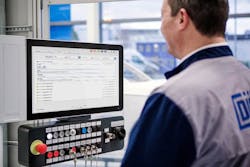There’s been quite a bit of activity recently around the implementation of artificial intelligence (AI) for quality inspection procedures. Most of these applications focused on the application of AI to machine vision systems to identify defective products based. But now we’re starting to see AI more widely applied to other automation technologies—such as robots—to inspect operations as they are performed by the robot.
Higher-end robotic systems have been incorporating AI for such applications for a while, but now Dürr, a supplier of turnkey paint shops, final assembly systems, and machine and robot technologies to the automotive industry, is expanding the scope of its AI applications with analysis software from its DXQ product family. According to Dürr, this interface makes it possible to incorporate robots into existing paint shops for the first time.
“Without this basic prerequisite, software from the DXQ family cannot determine the current state of plant components. The goal is to combine this data with historical data and machine learning to detect previously unknown defect sources or, more precisely, plan maintenance intervals,” explains Jens Häcker, vice president of control systems at Dürr.
Häcker says that factories in the automotive industry have “enormous amounts of latent data about manufacturing processes, raw materials, and products. The key to leveraging these data assets is connectivity with the right interface at the control level to get at the information provided by robots, ovens, cathodic electrocoating systems or conveyor technology. Operators in existing plants are often constrained because most of their systems do not have connectivity and the right interface for data acquisition.”
Providing this kind of interface for existing robots drove Dürr to develop its DXQequipment.analytics software to bring connectivity to many types of existing robots.
The technology offered by Dürr is an adapter comprised of hardware and software components that can connect to all current fieldbus technologies and provide data in the few milliseconds range. The adapter is offered by Dürr in cooperation with Techno-Step, a specialist in systems for process data analytics and diagnostics that has been part of the Dürr Group since 2020. According to Dürr, this hardware and software combination make it possible for inventory and third-party plant equipment to be intelligently networked with Dürr’s DXQ software products. This enables older generations of robots to exchange data, allowing the relevant processes to be analyzed by Dürr’s digital product portfolio.
We have already been able to validate a number of algorithms for painting with BMW. These can be models that provide a prediction for maintenance, like the ideal replacement time of the two-component mixer based on its wear.
To meet the challenge of analyzing robot and process data for robotic automotive painting requirements, Dürr uses its expertise in production technology and manufacturing processes in the automotive industry to apply AI in the detection of defect sources at an early stage when applying high-viscosity materials and to determine optimal maintenance schedules.
“Operators are thus able to read the available sensor and actuator data from their existing plants and integrate the entire spectrum of painting disciplines, from pretreatment to application to conveyor technology, into one piece of analytical software. With DXQequipment.analytics they get detailed insight into the various process steps and all the systems involved in them along the entire value chain,” says Häcker.
The DXQequipment.analytics software includes an Advanced Analytics module, which uses AI to increase overall equipment effectiveness (OEE) in the paint shop.
One example of the application of DXQequipment.analytics in paint shop robots is the detection of nozzle clogs. When the sealing material partially clogs the application nozzle, it can lead to quality defects that require rework to fix, according to Häcker. “Unlike conventional control technology, the DXQ software detects this defect and enables earlier intervention,” he says.
Häcker notes that Dürr currently has several beta customers working with DXQequipment.analytics to validate the machine learning models under real-world operating conditions.
“For example, we have already been able to validate a number of algorithms for painting with BMW,” he says. “These can be models that provide a prediction for maintenance, like the ideal replacement time of the two-component mixer based on its wear. Dürr offers these kinds of predictions with the Maintenance Bundle option. In our Quality Bundle, the customer receives support for predicting changes in quality; for example, changes in the shaping air, which is used to adjust the spray jet width of the paint application.”
Leaders relevant to this article:




